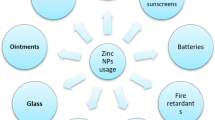Abstract
Recent research on potential carcinogens in recreational waters has spawned public concerns about the long-term public health impacts of disinfectants used in pools. However, no attention has been given to the ecological and public health impacts of metal oxides in cosmetics and sunscreens within swimming pools where leisure activities occur. The discussion in this perspective focuses on the interaction between metal oxide nanoparticles released from swimmers into pools where algae is present, and the synergistic toxicological effects of pool algae adsorbed by metal oxide nanoparticles in the presence of disinfection byproducts in comparison to the absence of contaminants. This perspective will address research approaches to evaluating metal oxide nanoparticle impacts on pool algae, and the challenge of identifying the potential mechanisms leading to transformed algae.

Similar content being viewed by others
References
Adams, L. K., Lyon, D. Y., & Alvarez, P. J. J. (2006). Comparative eco-toxicity of nanoscale TiO2, SiO2, and ZnO water suspensions. Water Research, 40, 3527–3532.
Barlow, P. G., Donaldson, K., MacCallum, J., Clouter, A., & Stone, V. (2005). Serum exposed to nanoparticle carbon black displays increased potential to induce macrophage migration. Toxicology Letters, 155, 397–401.
Battin, T. J., Kammer, F. D., Weilhartner, A., Ottofuelling, S., & Hofmann, T. (2009). Nanostructured TiO2: transport behavior and effects on aquatic microbial communities under environmental conditions. Environmental Science and Technology, 43, 8098–8104.
Crane, M., Handy, R. D., Garrod, J., & Owen, R. (2008). Ecotoxicity test methods and environmental hazard assessment for engineered nanoparticles. Ecotoxicology, 17, 421–437.
Ham, H. T., Choi, Y. S., & Chung, I. J. (2005). An explanation of dispersion states of single-walled carbon nanotubes in solvents and aqueous surfactant solutions using solubility parameters. J Colloid Interf Sci, 286, 216–223.
Handy, R. D., Henry, T. B., Scown, T. M., Johnston, B. D., & Tyler, C. R. (2008). Manufactured nanoparticles: their uptake and effects on fish—a mechanistic analysis. Ecotoxicology, 17, 396–409.
Huang, J., Graham, N., Templeton, M. R., Zhang, Y., Collinds, C., & Nieuwenhuijsen, M. (2009). A comparison of the role of two blue-green algae in THM and HAA formation. Water Research, 43, 3009–3018.
Joo, S. H., Al-Abed, S. R., & Luxton, T. (2009). Influence of carboxymethyl cellulose for the transport of titanium dioxide nanoparticles in clean silica and mineral-coated sands. Environmental Science and Technology, 43, 4954–4959.
Kashiwada, S. (2006). Distribution of nanoparticles in the see-through medaka (Oryzias latipes). Environmental Health Perspect, 114, 1697–1702.
Nel, A., Xia, T., Mädler, L., & Li, N. (2006). Toxic potential of materials at the nanolevel. Science, 311, 622–627.
Oberdörster, E. (2004). Manufactured nanomaterials (Fullerenes, C60) induce oxidative stress in the brain of juvenile largemouth bass. Environmental Health Perspect, 112, 1058–1062.
Oberdörster, G., Ferin, J., Gelein, R., Soderholm, S. C., & Finkelstein, J. (1992). Role of the alveolar macrophage in lung injury—studies with ultrafine particles. Environmental Health Perspect, 97, 193–199.
Palhutcherson, S. (2011) 3 Most kinds of pool algae (http://ezinearticles.com/3-most-common-kinds-of-pool-algae). Accessed 16 May 2011.
Raisuddin, S., & Jha, A. N. (2004). Relative sensitivity of fish and mammalian cells to sodium arsenate and arsenite as determined by alkaline single-cell gell electrophoresis and cytokinesis-block micronucleus assay. Environmental and Molecular Mutagenesis, 44, 83–89.
Sayes, C. M., Wahi, R., Kurian, P. A., Liu, Y., West, J. L., Ausman, K. D., Warheit, D. B., & Colvin, V. L. (2006). Correlating nanoscale titania structure with toxicity: a cytotoxicity and inflammatory response study with human dermal fibroblasts and human lung epithelial cells. Toxicological Sciences, 92, 174–185.
Thill, A., Zeyons, O., Spalla, O., Chauvat, F., Rose, J., Auffan, M., & Flank, A. M. (2006). Cytotoxicity of CeO2 nanoparticles for Escherchia coli: physico-chemical insight of the cytotoxicity mechanism. Environmental Science and Technology, 40, 6151–6156.
Wijnhoven, S. W. P., Dekkers, S., Hagens, W. I., & de Jong, W. H. (2009). Exposure to nanomaterials in consumer products. RIVM Letter Report, 340370001.
Author information
Authors and Affiliations
Corresponding author
Rights and permissions
About this article
Cite this article
Joo, S.H. The Ecotoxicological Impact of Metal Oxide Nanoparticles on Pool Algae in the Presence and Absence of Disinfection Byproducts: a New Research Direction for the Public Health and Safety of Engineered Nanoparticles used in Consumer Products. Water Air Soil Pollut 224, 1681 (2013). https://doi.org/10.1007/s11270-013-1681-3
Received:
Accepted:
Published:
DOI: https://doi.org/10.1007/s11270-013-1681-3




